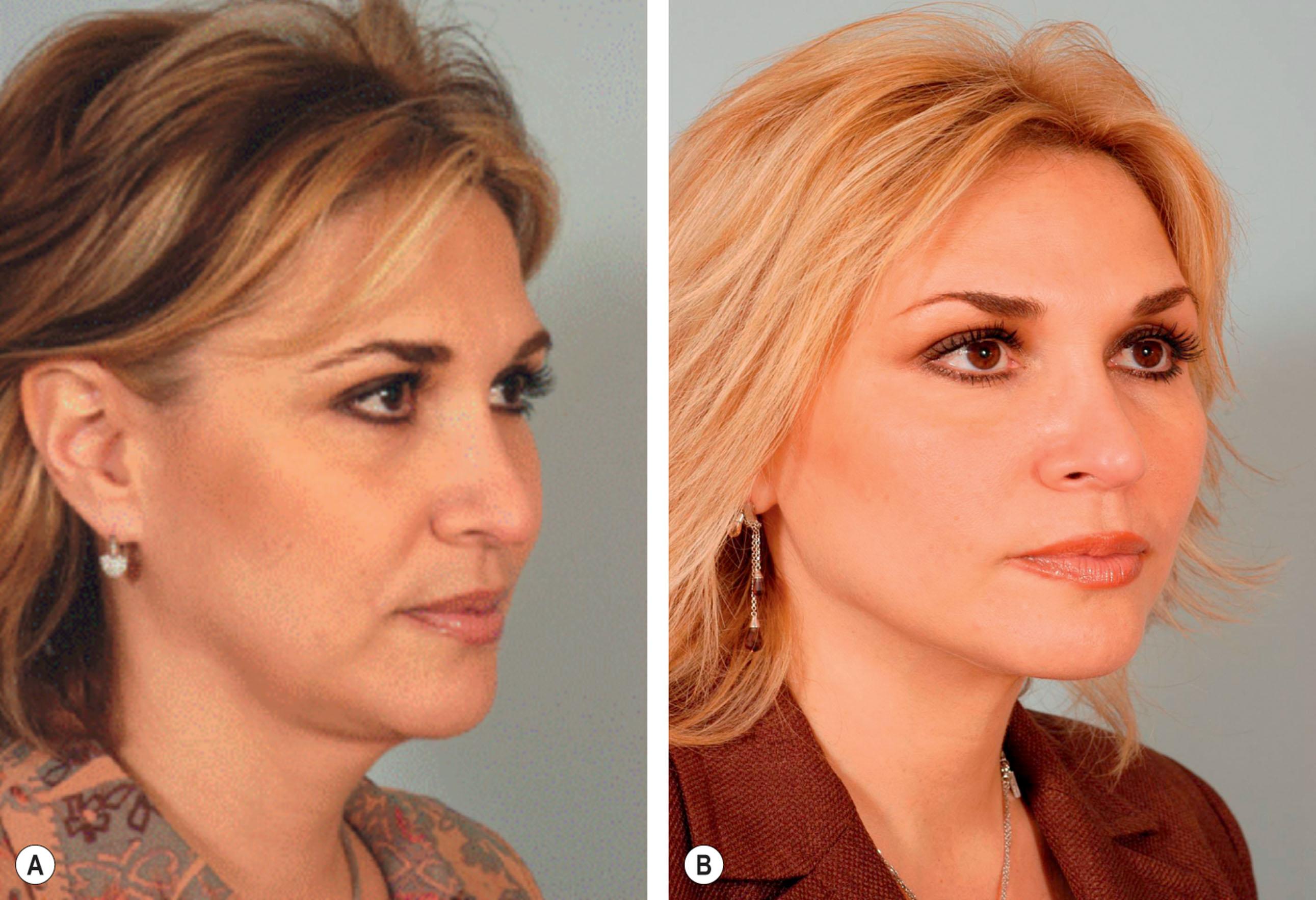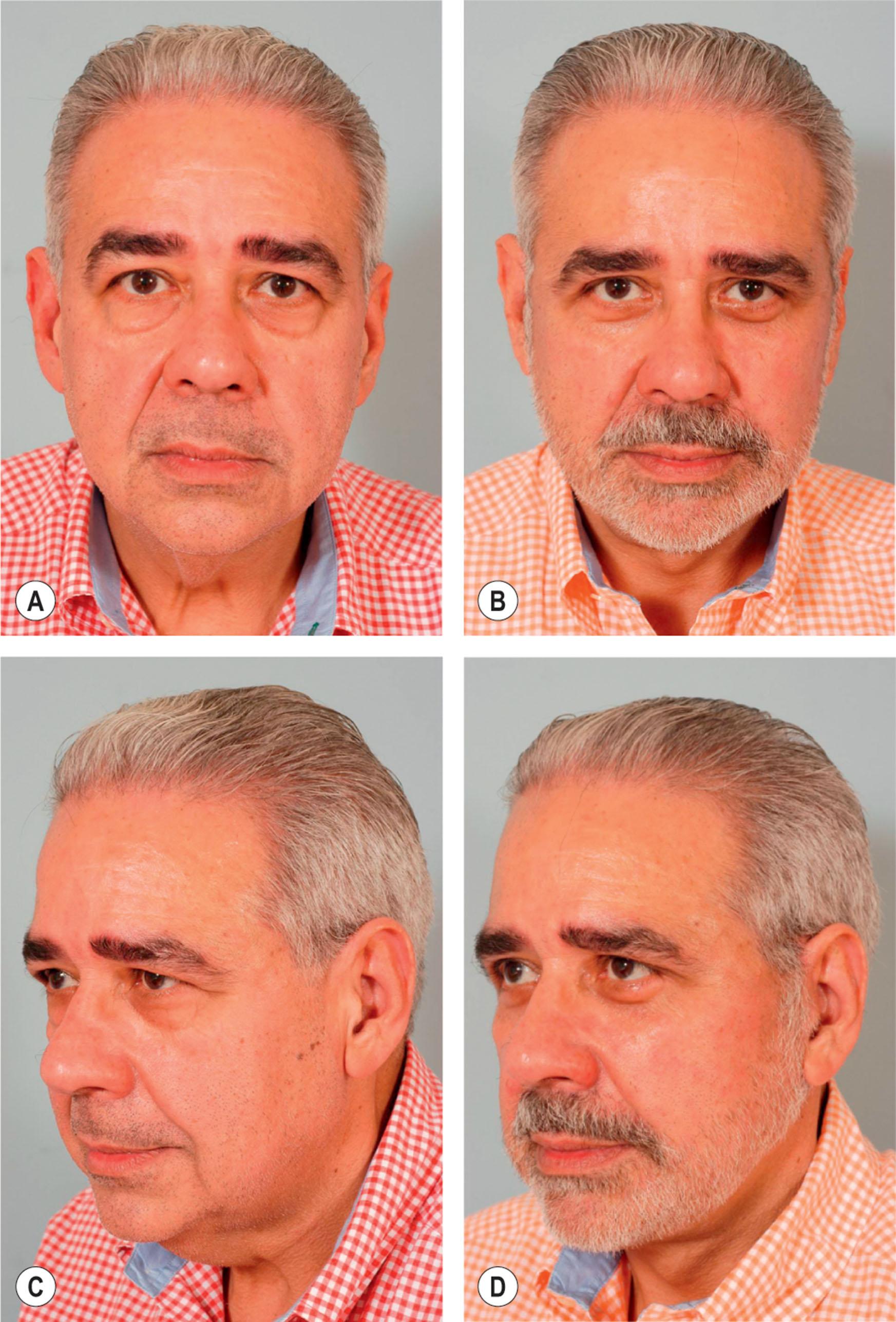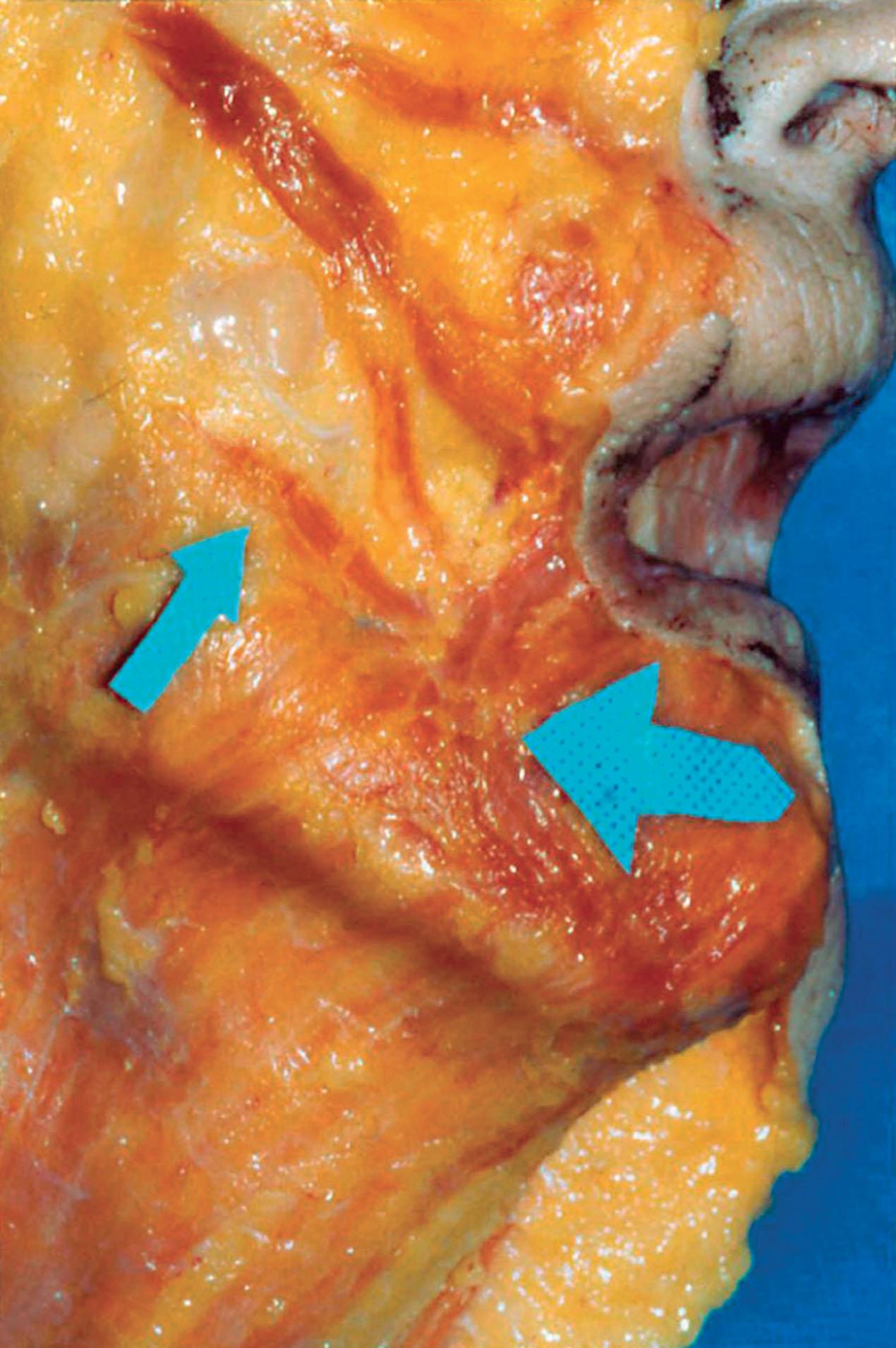Physical Address
304 North Cardinal St.
Dorchester Center, MA 02124
As the human face ages, many of the stigmata that are typically seen in aging relate to a change in the anatomic relationship that occurs between the superficial and deep facial fascia.
Improving technical control when contouring the superficial facial fascia and platysma provides for a more consistent, aesthetically pleasing result.
Performing a two-layer SMAS-type facelift requires commitment on the part of the surgeon, not only to understand facial soft-tissue anatomy but also to perform a procedure that demands technical precision.
A two-layer SMAS-type facelift is a time-consuming operation, with both the skin flap elevation as well as the dissection of the SMAS requiring meticulous and accurate dissection.
Obtaining consistency with this procedure is challenging because of the variability in thickness of subcutaneous fat and the SMAS that exists among individual patients
Following precise dissection, secure fixation of both SMAS and platysma is mandated to maintain the shaping desired in postoperative contour.
Meticulous hemostasis followed by careful skin flap inset are required to minimize postoperative scar perceptibility and ensure a rapid postoperative recovery.
The biggest advantage of the extended SMAS technique remains its aesthetic versatility, allowing the surgeon to vary the contouring aspects of the procedure according to the aesthetic needs of the patient.
Access video lecture content for this chapter online at Elsevier eBooks+ ![]()
Surgical rejuvenation of the aging face has evolved into one of the most frequently performed surgical procedures in the US. Facelifting, initially performed as a skin tightening procedure since the early 1900s, has technically matured during the past quarter of a century. This evolution is directly related to the scientific investigation of facial soft-tissue anatomy, resulting in a better understanding of the facial anatomic changes that occur with aging. Over the past 30 years, a plethora of procedures have evolved that utilize a variety of technical approaches, having as a common goal the reconstruction of aging-related anatomic changes.
The public's perception and the aesthetic concepts in facelifting have similarly evolved over time. Initially, both patients and surgeons focused solely on the laxity that occurs with facial aging, attempting to tighten what was loose rather than shape the face. Hence the term “facelift” (as opposed to “facialplasty”), a mechanical term implying a procedure, the goal of which is to lift what has fallen. Unfortunately, this mechanical approach to facial rejuvenation often produced a tight-appearing, operated look, the stigma of the “wind-tunnel appearance” so often associated with surgical rejuvenation of the aging face. Nonetheless, based on a better understanding of facial soft-tissue anatomy and the anatomic changes that occur in aging, facelifting has developed into both a reconstructive procedure (whose goal is to reconstruct the anatomic changes that occur with aging) as well as a more artistically defined technique that attempts to enhance facial appearance while minimizing signs that a surgical procedure has been performed ( ![]() ).
).
There are many treatment goals in facelifting besides simply correcting the hallmarks of the aging face, including improvement of the nasolabial folds and facial jowling, and correction of obliquity of cervical contour. As important as the mechanical aspects of tightening a loose, aged face are the aesthetic concepts of improving facial shape and bringing out the beauty in the face that existed during youth. To these goals, the surgeon attempting facial rejuvenation must have a thorough understanding of facial soft-tissue anatomy, comprehend the anatomic changes that occur in aging that produce a change in facial shape, and understand the ideal facial shape that can be obtained for a particular patient. Artistic design of surgical access incisions to minimize scar perceptibility, as well as prevent hairline distortion, is also key in preventing surgical stigmata.
The evolution of aging in the human face is complex and multifactorial. Problems that the plastic surgeon confronts in midface rejuvenation include (1) the dermal component of aging related to intrinsic and extrinsic skin changes (dermal elastosis); (2) facial fat descent; (3) facial deflation, which tends to be regionally specific; (4) radial expansion as facial fat becomes situated centrifugally away from the facial skeleton; and (5) the degree of skeletal support of the soft tissue, which influences both loss of volumetric highlights, as well as the descent of facial fat. All of these factors influence facial shape changes with aging. Individual patients will exhibit various degrees of these problems at the time they request surgery, and each component of the aging face should be addressed according to individual patient needs.
Evaluation of patient photographs taken during youth and middle age are helpful in determining how a specific patient has aged. Young photographs will usually demonstrate the location of the volumetric highlights present in youth or serve to document areas that have deflated over time, delineating both the position and vector of facial fat descent. These factors illustrate patient-specific changes in facial shape from youth to middle age, as well as clarifying the possibilities of methods that facial fat repositioning can improve and restore shape. From my perspective, the restoration of facial shape is a more worthy aesthetic goal than attempting to tighten a loose face.
The anatomic basis that allows rhytidectomy to be performed safely is that the facial soft tissue is arranged as a series of concentric layers. This concentric arrangement allows dissection within one anatomic plane to proceed completely separate from structures lying within another anatomic plane. The layers of the face are the: (1) skin; (2) subcutaneous fat; (3) superficial musculo-aponeurotic system (SMAS; superficial facial fascia); (4) mimetic muscles; (5) parotidomasseteric fascia (deep facial fascia); and (6) plane of the facial nerve, parotid duct, buccal fat pad, and facial artery and vein. (This information is thoroughly reviewed in Chapter 9.2 .)
In an overview of the architectural arrangement of the facial soft tissue, the essential point is that there is a superficial component of the facial soft tissue that is defined by the superficial facial fascia and includes the SMAS and those anatomic components that move facial skin (including superficially situated mimetic muscle invested by SMAS, the subcutaneous fat, and skin). This is in contrast to the deeper component of the facial soft tissue, which is defined by the deep facial fascia and those structures related to the deep fascia (including the relatively fixed structures of the face, such as the parotid gland, masseter muscle, periosteum of the facial bones, and facial nerve branches). As the human face ages, many of the stigmata that are typically seen in aging relate to a change in the anatomic relationship that occurs between the superficial and deep facial fascia. With aging, facial fat descends in the plane between superficial and deep facial fascia, and the radial expansion of the superficial soft tissue away from the facial skeleton occurs within this plane. In my opinion, these anatomic changes justify repositioning facial fat through subSMAS dissection to restore facial shape.
The communication between the superficial and deep facial fascia occurs at the level of the retaining ligaments, which are discussed in Chapter 9.2 . These structures fixate facial soft tissue in normal anatomic position, resisting gravitational forces. In the evolution of midface aging, the zygomatic and masseteric cutaneous ligaments bear particular attention. The zygomatic ligaments originate from the periosteum of the malar region. Their function is to fixate the malar pad to the underlying zygomatic eminence in the youthful face.
Support of the soft tissues of the medial cheek is provided by a series of fibrous bands that extend along the entire anterior border of the masseter muscle. These are the “masseteric cutaneous ligaments” and are identified superiorly in the malar area where they mingle with the zygomatic ligaments and extend along the anterior border of the masseter as far inferiorly as the mandibular border. These fibers represent a coalescence between the superficial and deep fascia, extending from the masseter muscle vertically to insert into the overlying dermis. These masseteric ligaments support the soft tissues of the medial cheek superiorly above the mandibular border in youth.
The surgical significance of the retaining ligaments is that they represent the anatomic communication between superficial and deep facial fascia. As this support system becomes attenuated, facial shape changes. The position of the retaining ligaments also dictates the degree of dissection required in a facelift. To adequately mobilize the skin flap, the dissection needs to be carried at least to the peripheral extent of the retaining ligament system, specifically dissecting the skin flap into the malar region, as well as past the anterior border of the masseter. Similarly, the location and restrictiveness of the retaining ligaments dictates the degree of SMAS elevation required to adequately release the superficial fascia. In general, this requires the surgeon to extend the SMAS dissection into the malar region, releasing the superficial fascia from the restraint of the zygomatic ligaments, the upper masseteric ligaments, and medial to the anterior border of the parotid.
As the human face ages, facial shape changes; morphologic facial changes are multifactorial. Some of these changes are straightforward to address, while others remain difficult technical challenges. A paradox has always been that facial anatomy (in terms of basic soft-tissue architecture) is essentially unchanged from youth to middle age, but facial appearance changes greatly over time and is patient-specific. Although each face ages differently, there are common themes noted in all aging faces.
As the human face ages, facial fat descends and, consequently, facial shape changes. Typically, the youthful face is full of well-supported fat. Volumetric highlights are located within facial aesthetic subunits, which have a high density of retaining ligaments (zygomatic eminence and zygomatic arch, preparotid, orbital rim) and serve to fixate this volume of fat to underlying structures. Juxtaposed to the volumetric fullness (or convexity) of the malar and preparotid region is commonly a concavity within the submalar region, overlying the buccinator muscle and buccal recess. The combination of fullness in the malar region and lateral cheek, associated with submalar concavity and a well-defined mandibular border, accounts for the angular, tapered appearance of the youthful face.
With aging, facial fat can descend and produce significant changes in facial shape. In middle age, as ligamentous support becomes attenuated, facial fat volumetrically becomes situated anteriorly and inferiorly in the cheek, producing a contour that is square and bottom heavy, with little differential between malar highlights and submalar fat. As facial fat is situated more inferiorly in the face, middle-aged faces appear vertically longer than young faces (see Fig. 9.3.7 ).
Youthful faces are full of well-supported facial fat. Over time, deflation occurs and this tends to be most apparent in regions of the face with a high density of retaining ligaments. For this reason, the areas that are noted to be volumetrically full in youth (malar, preparotid, lateral and infraorbital rim, lateral chin) become volumetrically deflated over time. With deflation, soft tissue becomes less supported and therefore appears lax. Youthful faces have a smooth blending of contour between the aesthetic subunits of the face. Middle-aged faces, secondary to both deflation and facial fat descent, develop lines of demarcation between one region of the face and another, which is intuitively identified as old. An accurate aesthetic treatment plan to improve facial shape requires the repositioning of descended soft tissue into areas of facial deflation to improve shape, not only by restoring volume to the position noted in youth, but also serving to blunt the lines of demarcation between aesthetic subunits. Volumetric augmentation through autologous fat injection or other injectable soft-tissue fillers are ancillary agents that can be useful in augmenting areas of deflation.
Deflation in the aging face is a complex process that tends to be regional and age-specific. Key elements in understanding how deflation occurs have been enlightened following an elucidation of the compartmentalization of subcutaneous fat within the cheek as defined by Rohrich and Pessa. What these investigators realized was that the cheek subcutaneous fat, rather than being homogeneous, is compartmentalized, with each facial fat compartment surrounded by specific septal membranes and with each compartment having an independent perforator blood supply. Aesthetically, the significance of compartmentalization of facial fat is that deflation tends to occur within a specific region of the cheek, explaining why the entire cheek does not deflate homogeneously ( Fig. 9.7.1 ).

At the risk of over-simplification, one key to understanding facial deflation is the recognition of the location of zygomaticus major muscle, which traverses from the malar eminence to the oral commissure. Deflation of the cheek lateral to the zygomaticus major muscle tends to occur independently from deflation in the malar region, medial to the zygomaticus major. For many patients, lateral cheek deflation develops at an earlier age than malar pad deflation and is often noted in patients in their forties. Medial cheek and malar pad deflation tend to occur later in life and is responsible not only for the loss of volumetric support within the anterior cheek, but also leads to the development of what has been termed the infraorbital V-deformity. Deflation in this region results in an apparent increase in the vertical length of the lower lid, as the lid–cheek junction visually descends inferiorly into the poorly supported anterior cheek ( Fig. 9.7.2 ).

An interesting region of deflation develops in some patients in the submalar region lateral to the oral commissure. In these patients, deflation can result in accentuation of the submalar concavity, which can become more obvious following the vertical soft-tissue shifts associated with facelifting procedures. An accentuation of submalar depression lateral to the oral commissure can result in the development of what has been termed “joker lines” or cross-cheek depressions, which are a typical stigmata that a patient has undergone a facelift. Avoidance of vertical soft-tissue repositioning in conjunction with volume addition in the submalar recess lateral to the oral commissure is useful in preventing the accentuation of postoperative cross-cheek depressions ( Fig. 9.7.3 ).

Not all facial aging is vertical and a major challenge in facial rejuvenation is the radial expansion of facial soft tissue that occurs along specific areas of the midface. In youth, the skin and underlying subcutaneous fat are densely attached to the deep facial fascia by retinacular fibers that transverse between skin, subcutaneous fat and superficial fascia, and insert into the deep fascia and facial musculature. Over time, with prolonged animation such as smiling, the skin along the nasolabial line is forced deep to the subcutaneous fat, positioned lateral to the nasolabial fold, attenuating these retinacular attachments. Prolonged animation therefore forces the skin and fat lateral to the nasolabial fold to expand radially and prolapse outward from the facial skeleton, accounting for much of the nasolabial fold prominence in the aging face. Radial expansion lateral to the oral commissure and marionette line similarly accounts for the prominence of the jowl in many middle-aged patients, making the older face appear square in shape and bottom heavy.
Radial expansion is technically difficult to correct, as there are few surgical solutions to re-establish the retinacular attachments between skin, subcutaneous fat and deep fascia. Nonetheless, repositioning of facial fat through some form of support to the superficial fascia will not only reposition fat vertically, but will also provide some degree of internal repositioning such that the superficial facial soft tissues lie closer to the facial skeleton. As the soft tissues become situated closer to the underlying deeper structures of the face, facial morphology tends to be restored to a more youthful configuration. Because of the technical difficulty in completely treating radial expansion in many faces, incomplete correction of both the jowl and nasolabial fold resulting in undercorrection can be noted postoperatively despite heroic efforts at repositioning descended facial fat.
Become a Clinical Tree membership for Full access and enjoy Unlimited articles
If you are a member. Log in here